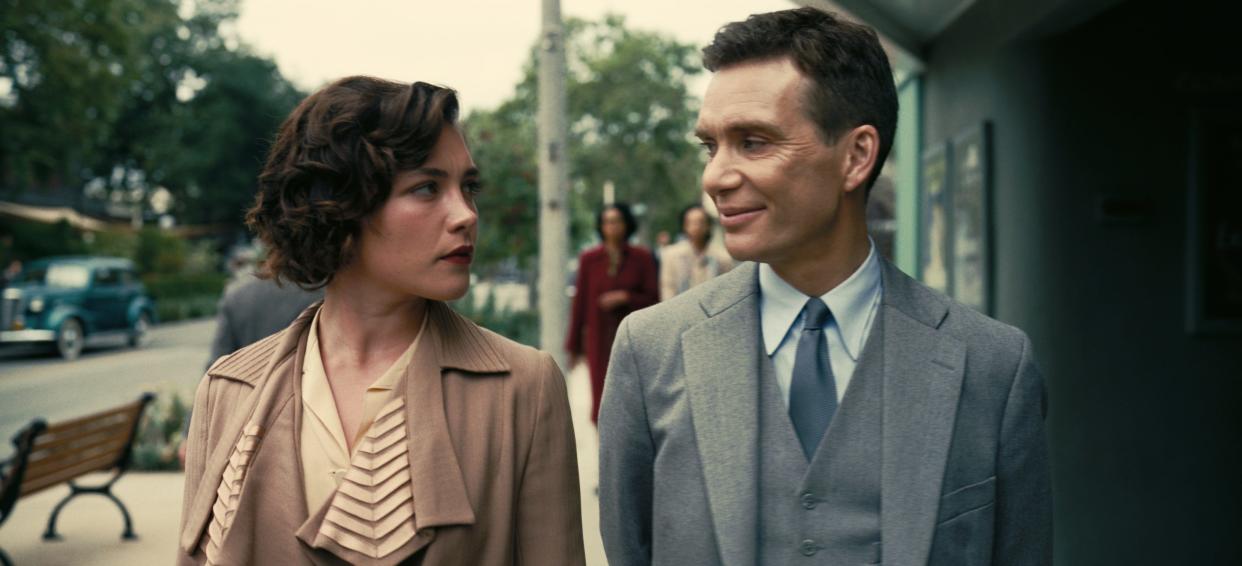What really happened to Oppenheimer's ex Jean Tatlock, whose life is more complex than what the movie shows

Warning: Spoilers ahead for Chistopher Nolan's movie, "Oppenheimer."
The film suggests Oppenheimer's former girlfriend, Jean Tatlock, died by suicide.
Though that's believed to be the case, her death was also the subject of conspiracy theories.
The fate of Jean Tatlock, J. Robert Oppenheimer's first girlfriend and lover, is pretty cut and dried in "Oppenheimer," which suggests the psychologist and Communist party member died by suicide. But in real life, Tatlock's death became the subject of scrutiny, with some suspecting foul play.
At the end of director Christopher Nolan's three-hour biopic on Oppenheimer and the creation of the atomic bomb, Florence Pugh's Tatlock is shown submerging her head under water in a bathtub.
The scene is supposed to be from Oppenheimer's point of view. According to the film's production notes, scenes in color (as opposed to those in black-and-white) are "told through Oppenheimer's perspective," with Nolan writing his scenes in the first person to get a peek inside his head.
As Oppenheimer wasn't present when Tatlock died, the audience is seeing how he imagined Tatlock's final moments. On screen, he blames himself for her death, since he refused to continue seeing her.
Though Tatlock's death appears straightforward to the audience, it's unclear if we're receiving the full picture of events, since it's depicted from Oppenheimer's point of view.
How did Jean Tatlock actually die?

The scene in "Oppenheimer" stays true to an account of how Tatlock was found.
Tatlock died in her San Francisco apartment in January 1944 at the age of 29. According to Ray Monk's "Robert Oppenheimer: A Life Inside the Center," her father discovered her "in the bath, her head submerged in water."
He found a note on her kitchen table saying she'd become "disgusted with everything," believed she "would have been a liability all my life," and "could take away the burden of a paralyzed soul from a fighting world" by taking her own life.
When Oppenheimer was later accused of having communist ties, his security clearance to access restricted data became of concern, leading to a hearing in 1954. During this four-week security clearance hearing, which spans 19 volumes of transcript, Oppenheimer was asked about his relationship with Tatlock.
Monk's book references some of this transcription, in which Oppenheimer said he visited Tatlock on June 14, 1943 at her apartment, noting, "I felt that she had to see me. She was undergoing psychiatric treatment. She was extremely unhappy."
Monk's book says Tatlock was receiving psychoanalysis from a Freudian doctor, Siegfried Bernfeld, at the time, as she worked as a child psychiatrist.
Oppenheimer claimed Tatlock was "still in love" with him and that he "spent the night" with her after going out to a bar, eating and having a few drinks, and returning to her apartment.
Monk notes the two were followed by agents. Oppenheimer, who was already being closely watched because of concerns about possible communist ties, had been assigned two counterintelligence bodyguards and had his phone tapped. The FBI additionally tapped Tatlock's phones, but "no information relevant to the protection of the U.S." was ever acquired.
According to "American Prometheus: The Triumph and Tragedy of J. Robert Oppenheimer," the book the film is based on, this was the final time Oppenheimer and Tatlock saw one another.
Though Tatlock's official death was listed as suicide, some suspected she was murdered.
The most prominent conspiracy theory is that Tatlock was killed by Manhattan Project intelligence agents. Some were concerned Oppenheimer may have been using Tatlock to pass details of the Manhattan Project to members of the Soviet Union.
Tatlock's autopsy showed she had sedatives, including traces of chloral hydrate, in her system. "Oppenheimer" appears to show some pills fall into the tub alongside her. The Atomic Heritage Foundation notes most historians concluded that Tatlock likely died by suicide.
'Oppenheimer' only scratches the surface of Tatlock's life

Audiences receive a vague portrayal of Tatlock in "Oppenheimer." The film does little to convince audiences why the two were so drawn to one another, other than showing them exchanging a few brief lines at a party and bonding over Oppenheimer's ability to read Sanskrit (a language the physicist did know) before sleeping together.
But the two dated long enough (1936-1939) for Oppenheimer to propose to Jean twice only to be shut down, something not depicted on screen.
It's also believed that Tatlock struggled with her sexuality. In Shirley Streshinsky and Patricia Klaus' "An Atomic Love Story: The Extraordinary Women in Robert Oppenheimer's Life," there's reference to a letter Tatlock wrote to another woman in 1930 where she said she thought she may be gay.
It's unclear whether or not Oppenheimer was aware of this, but the film may contain a subtle reference when he tells Tatlock, "We both know I'm not what you want." Otherwise, this is also never explored.
Instead, Nolan's film contains a running joke about Tatlock tossing out flowers whenever Oppenheimer offers them. It's supposed to play for laughs and perhaps make Tatlock look a little more cold and tough.
In the film, Oppenheimer continues to pursue and stay in touch with Tatlock, who consistently pushes him away. But a mention of Tatlock's potential struggles with her sexual identity would have added to understanding her back-and-forth relationship with Oppenheimer.
Instead, the film largely utilizes Tatlock to exploit the sexual nature of their relationship, gratuitously showcasing Pugh half-nude twice.
Unfortunately, that will likely be the audience's main takeaway from the character, when the real Tatlock appeared to live a tortured and tragic existence.
Read the original article on Insider


